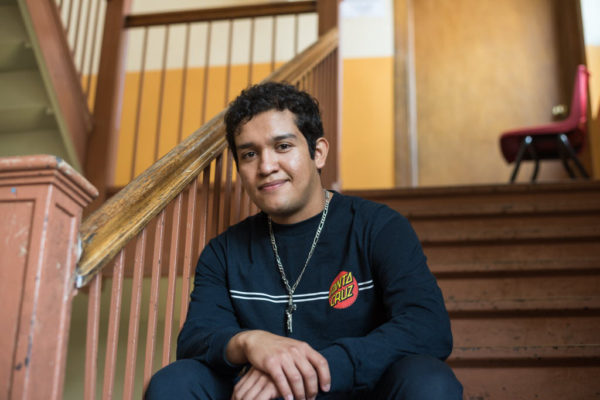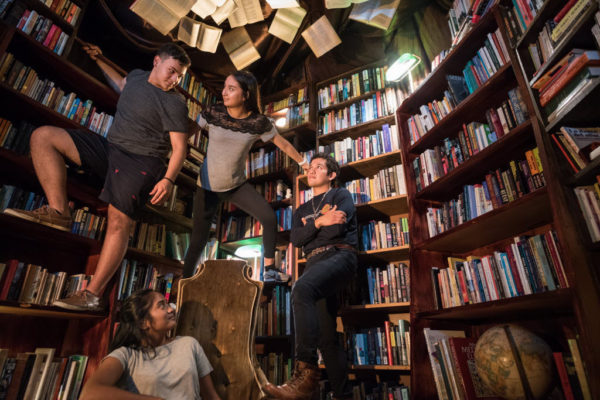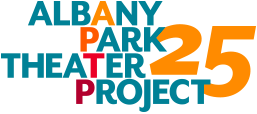Chicago Sun-Times//Hedy Weiss: Think of it as a fantasia on life in a Chicago public high school, performed throughout the three floors of an actual school building by actors who are either still in high school or have just begun college.
In a stairwell, a lovesick boy tries to convince a girl that she should go to the prom with him. Music plays. Her long hair streams over the staircase. And he gives her three reasons why she should accept his invitation: she brightens his day, she is the only one who can make him dance, and there is no one he would rather “be more high school with.”
In a library that resembles something out of a Victorian dream, a girl poses questions to her visitors about their tastes in reading, and then climbs into the stacks to retrieve books that might fit the bill.
And in a math class, restless students pass notes, deploy paper missiles and suddenly erupt in counterpointed movement, clambering up, over and around their well-worn combination chair/desks in choreography that suggests escape more than rebellion.
Welcome to “Learning Curve,” the world premiere piece now in rehearsal by Chicago’s Albany Park Theater Project, the multiethnic youth ensemble that has won acclaim for such productions as “Feast,” “God’s Work” and “Home/Land,” produced at both its field house home and on the stage of its frequent partner, the Goodman Theatre. It’s being created in collaboration with Third Rail Projects, a New York-based immersive theater ensemble whose award-winning work “Then She Fell” fused the writings of Lewis Carroll with a hospital ward backdrop.
With a cast of 31 performers ranging in age from 13 to 19 (who possess the skill and passion of seasoned professionals), “Learning Curve” will unfold throughout the three floors of the Ellen Gates Starr High School (the fictional name for an actual shuttered Catholic school that is the site of the performance), which has been specially outfitted with 30 air conditioners, 45 speakers and 5,000 feet of cable.
Audiences will be limited to just 40 people, none of whom will have the exact same experience or move along the same route, with the most “prized” element being several one-on-one interactions. (NOTE: The school has no elevator, and the show requires a good deal of mobility, so it is not recommended for those who have trouble climbing stairs or standing for an extended length of time.)
“The idea of doing something in and about a school has been on our minds for years,” said APTP’s artistic director, David Feiner, who is devising “Learning Curve” (two years in development) along with Third Rail’s Jennine Willett, and in collaboration with Stephanie Paul, Maggie Popadiak and Rosanna Rodríguez-Sanchéz of APTP, Marissa Nielsen-Pincus, Edward Rice and Carlton Cyrus Ward of Third Rail Projects, the cast, and a team of Chicago designers. “Things coalesced when Maggie and I went to see Third Rail Projects’ ‘Then She Fell,’ were awestruck, and finally reached out to them to see if they’d just do a workshop with us.”
“In some ways it was scary to do a piece so close to home,” Feiner confessed. “APTP is about to turn 20, and the Chicago Public School system has been beleaguered throughout that whole time. But for the moment our biggest challenge is figuring out all the logistics, and synchronizing things with the change-of-class bells.”
THE TEACHERS WHO MADE A DIFFERENCE:
Five members of Albany Park Theater Project’s “Learning Curve” cast recently gathered to recall the teachers who had the greatest impact on them. Despite their intense connection to theater, none of them named a drama teacher as a pivotal force and this made perfect sense, for if you watch these young actors at work you realize they are drawing on things far deeper than “acting” technique.

Hector Velazquez, a member of the cast of Albany Park Theater Project’s show “Learning Curve.” (Photo: Max Herman for the Sun-Times)
“My eighth grade literature teacher, Mr. Rizzo, played guitar in a band. I had messed around with the guitar since sixth grade, but he was the first adult besides my parents who showed any interest in my playing. He taught me some chords in an after-school class, and he also made me love poetry, especially Edgar Allan Poe.” (Hector Velazquez, 19, born in Mexico)
“Mrs. Lemer, my second grade teacher at McPherson Elementary School, was a descendant of Holocaust survivors. After we had a Day of Remembrance in class I asked her more about the Holocaust and she explained it to me, and what she said really stuck with me. I also had a speech impediment, and she was so kind in explaining how I could process it, and understand other people’s intentions, and she also encouraged me to get therapy. She taught me what it means to be a human being in a world like this.”
18, born in Philippines

Alyanna Parajado, 18, poses for a portrait in a room at Starr High School, the backdrop for Albany Park Theater Project’s immersive work, “Learning Curve.” (Photo: Max Herman for the Sun-Times)
“I struggled with chemistry and all science classes, but Mr. Reed, my chemistry teacher at Amundsen High School, went out of his way to help me and others with after-school tutoring. I would stop by to talk to him during my junior and senior years, too, because he offered great advice.” (Alyanna Parajado, 18, born in Philippines)
“When I moved from Texas to Chicago I spoke no English and I was put in a bilingual class for first and second grade. At first I had very bad grades, but my teacher, Mrs. Santiago at Volta Elementary School in Albany Park, really helped me, and I was soon put into advanced classes. She was very in touch with her class and you could communicate with her.”
17, born in Texas, of Mexican heritage
“For me it was Miss Nguyen, who was of Vietnamese heritage, and taught English and the theory of knowledge at Amundsen High School. Her main goal was to help her students succeed, and she was always there to offer special coaching. Her motto was: Your success is my success.”
18, born in Chicago, of Mexican heritage

Abraham "Kito" Espino (clockwise, from top left), Chelsee Nava, Hector Velazquez and Alyanna Parajado, inside the library of Starr High School, the setting for "Learning Curve," Albany Park Theater Project's immersive show. (Photo: Max Herman for the Sun-Times)
Hedy Weiss, Chicago Sun-Times
 Menu
Menu